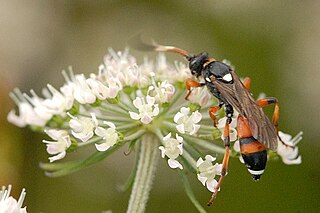Related Research Articles

The ovipositor is a tube-like organ used by some animals, especially insects for the laying of eggs. In insects, an ovipositor consists of a maximum of three pairs of appendages. The details and morphology of the ovipositor vary, but typically its form is adapted to functions such as preparing a place for the egg, transmitting the egg, and then placing it properly. For insects, the organ is used merely to attach the egg to some surface, but for many parasitic species, it is a piercing organ as well.

The superfamily Ichneumonoidea contains one extinct and three extant families, including the two largest families within Hymenoptera: Ichneumonidae and Braconidae. The group is thought to contain as many as 100,000 species, many of which have not yet been described. Like other parasitoid wasps, they were long placed in the "Parasitica", variously considered as an infraorder or an unranked clade, now known to be paraphyletic.

The Ichneumonidae, also known as the ichneumon wasps or ichneumonids, is a parasitoid wasp family within the insect order Hymenoptera. This insect family is among the most species-rich branches of the tree of life. At the same time, it is one of the groups for which our knowledge most severely lags behind their actual diversity. The roughly 25,000 species described today probably represent less than a quarter of their true richness, but reliable estimates are lacking, as is much of the most basic knowledge about their ecology, distribution and evolution. Ichneumonid wasps, with very few exceptions, attack the immature stages of holometabolous insects and spiders, eventually killing their hosts. They thus fulfill an important role as regulators of insect populations, both in natural and semi-natural systems, making them promising agents for biological control.

Megarhyssa is a genus of large ichneumon wasps, with some species known for having the longest ovipositors of any insects. They are idiobiont endoparasitoids of the larvae of wood-boring horntail wasps. The ovipositor can be mistaken for a large stinger.
Ichneumon may refer to:
In the 10th edition of Systema Naturae, Carl Linnaeus classified the arthropods, including insects, arachnids and crustaceans, among his class "Insecta". He described the Insecta as:
A very numerous and various class consisting of small animals, breathing through lateral spiracles, armed on all sides with a bony skin, or covered with hair; furnished with many feet, and moveable antennae, which project from the head, and are the probable instruments of sensation.
In the 10th edition of Systema Naturae, Carl Linnaeus classified the arthropods, including insects, arachnids and crustaceans, among his class "Insecta". Insects with membranous wings, including bees, wasps and ants were brought together under the name Hymenoptera.

Rhyssa persuasoria, the giant ichneumon, is a species belonging to the family Ichneumonidae subfamily Rhyssinae.

Echthromorpha intricatoria, also known as the cream-spotted ichneumon, is a common wasp found in Australia and New Zealand. It cannot sting and does not build nests, and is harmless to humans. The female injects eggs into pupae of moths and butterflies with the ovipositor, particularly favouring the Nymphalidae. Metacrias huttoni has been shown to be a host species for E. intricatoria.

Ichneumon is a genus of parasitic wasps in the family Ichneumonidae.
Diadegma chrysostictos is a wasp first described by J.F. Gmelin in 1790. No subspecies are listed.

Amblyteles armatorius is a species of parasitic wasp in the family Ichneumonidae first described by Johann Reinhold Forster in 1771.

Xanthopimpla punctata, also known as the yellow ichneumon wasp, is a yellow-colored Ichneumon wasp of subfamily Pimplinae. Xanthopimpla spp. play a beneficial role in agriculture. They are important parasitoids of lepidopterous stem borers of cereals, sugar cane and other crops; they lay their eggs on moth caterpillars that damage crops.

Ichneumon sarcitorius is a species of wasp belonging to the family Ichneumonidae subfamily Ichneumoninae.

Ichneumon extensorius is a species of parasitic wasp in the genus Ichneumon. It was described by Carl Linnaeus in 1758.
Ichneumon nyassae is a species of wasp in the genus Ichneumon. It is endemic to Tanzania.
Ichneumon rubriornatus is a species of wasp in the genus Ichneumon. It was described by Peter Cameron in 1904.
Ichneumon unicinctus is a species of wasp in the genus Ichneumon. It is endemic to Madagascar, Mauritius and Réunion.

Megarhyssa macrurus, is a species of large ichneumon wasp.
Ichneumon eumerus is a species of parasitic wasp belonging to the family Ichneumonidae, subfamily Ichneumoninae. It is a specialist parasite of the larva of the mountain Alcon blue butterfly.
References
- ↑ "Ichneumon tottor - WaspWeb" . Retrieved 19 February 2016.
| | This Ichneumonidae-related article is a stub. You can help Wikipedia by expanding it. |